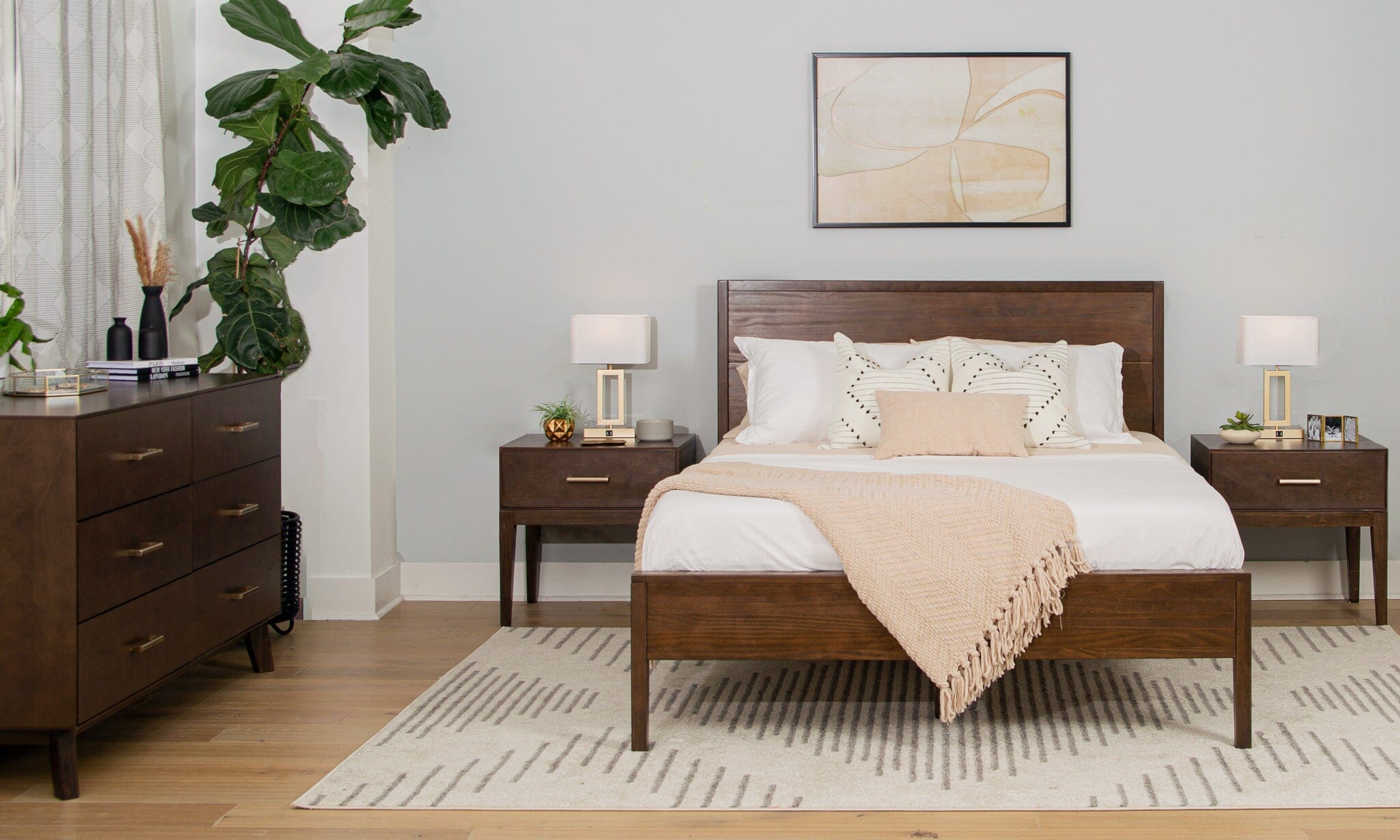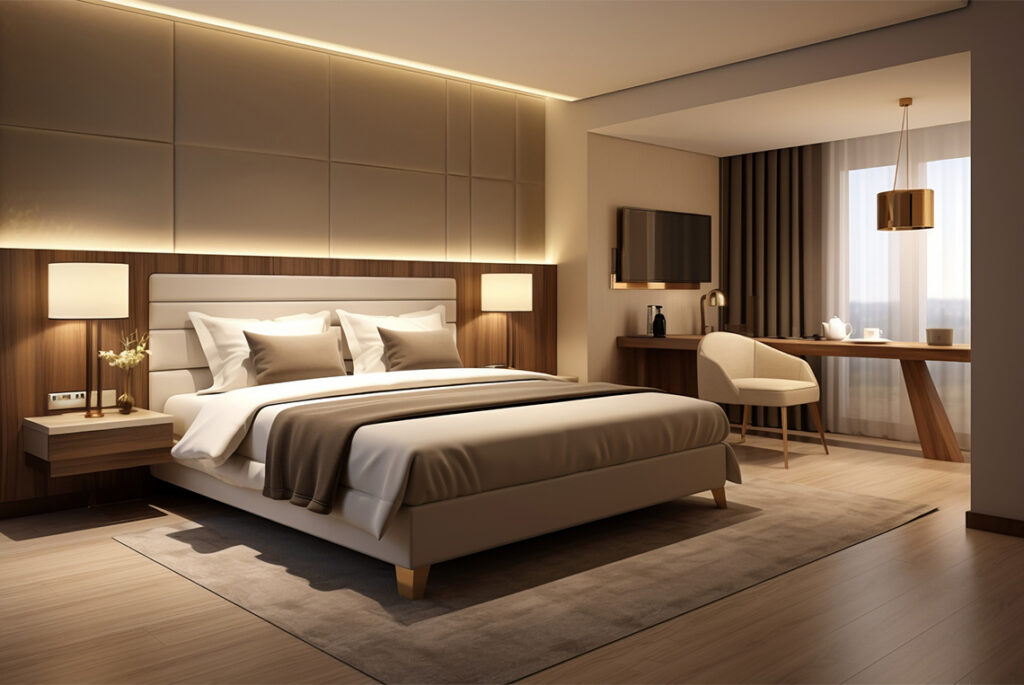Blog
Minimalist Bedroom Designs for a Peaceful Retreat
A minimalist bedroom is more than just a design choice—it’s a lifestyle that promotes calm, clarity, and relaxation. The minimalist approach to bedroom design focuses on simplicity, functionality, and tranquility, removing distractions and creating a serene space where you can truly unwind. If you’re looking to transform your bedroom into a peaceful retreat, here are key principles and design ideas to help you achieve the perfect minimalist sanctuary.

1. Embrace Clean Lines and Simple Forms
At the heart of minimalist design is the principle of clean lines and simple forms. This means avoiding overly ornate furniture, decorative elements, or clutter. Instead, focus on sleek, functional pieces that contribute to a calm, organized space.
- Furniture: Opt for beds, nightstands, and dressers with straightforward designs. Platform beds, low-profile frames, and smooth finishes work well in minimalist bedrooms. Consider simple wooden or metal frames that emphasize function over decoration.
- Decor: Keep decorative pieces to a minimum. Select one or two statement items, such as a piece of art or a unique light fixture, and avoid overcrowding surfaces. The goal is to keep the focus on the essentials while maintaining a sense of openness and balance.
2. Neutral and Soothing Color Palette
Color plays a vital role in creating a peaceful atmosphere in your bedroom. Minimalist bedroom designs typically feature a neutral color palette, which helps promote relaxation and a sense of calm.
- Soft Whites and Grays: Shades of white, ivory, or light gray provide a fresh and clean backdrop, making the room feel airy and spacious. These colors also have a timeless quality that works with any style of furniture.
- Beiges and Taupes: Earthy tones like beige, taupe, and soft browns create a warm and inviting space. These colors are ideal for creating a cozy, yet minimal, environment.
- Accent Colors: If you want to add a touch of color, choose one or two muted accent shades. Soft pastels, gentle blues, or earthy greens can evoke a sense of tranquility without overwhelming the space.
3. Focus on Natural Materials
In minimalist bedroom designs, the use of natural materials is key. These materials not only add texture and warmth but also connect the space to nature, enhancing the overall sense of calm.
- Wood: Choose furniture made from natural wood with clean finishes, such as light oak, walnut, or birch. Wood adds a warm, organic touch while keeping the design grounded and inviting.
- Linen and Cotton: Opt for natural bedding materials like linen or cotton. These fabrics are breathable, soft, and durable, and they add a natural element to the room. Neutral-colored sheets, throws, and duvet covers keep the look minimal while providing comfort.
- Stone and Ceramic: Incorporating subtle stone or ceramic elements, such as a stone vase or ceramic lamp, adds texture and natural beauty without cluttering the space.
4. Declutter for a Calm Environment
One of the cornerstones of minimalist design is decluttering. A clutter-free space promotes peace and reduces stress. To create a serene minimalist bedroom, ensure that everything has its place, and avoid excessive items on display.
- Storage Solutions: Invest in smart storage solutions to keep your bedroom organized. Under-bed storage, built-in shelves, and minimalist dressers can help keep your belongings hidden and out of sight.
- Keep Surfaces Clear: Limit the number of items on nightstands, dressers, and shelves. A few well-chosen accessories, like a simple candle or a small plant, can add personality without overwhelming the space.
- Organized Closets: An organized closet is essential for maintaining a minimalist bedroom. Consider sleek wardrobe systems or open shelving units to keep clothes neatly stored while maintaining the room’s minimalist aesthetic.
5. Natural Light and Simple Lighting Fixtures
Lighting is crucial in a minimalist bedroom, as it can significantly impact the mood of the space. Natural light should be a key element, and the artificial lighting you choose should be functional and subtle.
- Maximize Natural Light: Use light, airy curtains or blinds that let in as much natural light as possible. Large windows, if available, should be kept unobstructed to create an open, light-filled atmosphere.
- Soft Lighting: Choose simple, clean lighting fixtures, such as pendant lights or wall sconces. The goal is to provide soft, ambient lighting that adds warmth to the room without drawing attention to the fixtures themselves. Consider using dimmable lighting to adjust the ambiance depending on the time of day.
- Avoid Overhead Lights: Instead of relying solely on overhead lights, incorporate table lamps or floor lamps with minimalist designs. These fixtures create softer, more intimate lighting that adds to the room’s tranquil vibe.
6. Incorporate Functional Yet Stylish Accessories
In a minimalist bedroom, accessories should serve a dual purpose—both functional and decorative. Keep your accessories simple and thoughtfully chosen to maintain the serene ambiance.
- Bedding: Keep your bedding simple, using neutral tones and soft textures. A well-made bed with a crisp duvet cover and minimalist throw pillows creates a calm, inviting focal point in the room.
- Artwork: Opt for a single piece of artwork or a few framed photographs that resonate with you. Large, bold artwork can serve as a statement piece, while smaller, simpler prints or photos contribute to the minimalist aesthetic.
- Rugs: A minimalist bedroom can benefit from a simple, neutral-colored rug that adds comfort underfoot without overwhelming the space. Opt for natural fibers like wool or jute for a tactile, earthy feel.
7. Create an Open Layout
Minimalist bedrooms often feature an open layout that promotes ease of movement and a sense of freedom. Avoid overcrowding the room with unnecessary furniture, and instead, focus on maximizing space.
- Open Space: Keep pathways clear and open, allowing for easy movement around the room. Avoid placing furniture in a way that creates congestion or makes the room feel cramped.
- Simple, Functional Layout: Arrange furniture in a way that highlights the room’s features and allows for a natural flow. The bed should be the focal point, with other elements—such as nightstands, chairs, or storage units—positioned to complement the bed without dominating the space.
8. Add Subtle Greenery
Plants are a perfect way to introduce life and freshness into a minimalist bedroom. Choose plants that require minimal maintenance and are known for their air-purifying qualities.
- Succulents: Small, low-maintenance succulents are ideal for minimalist spaces. Their clean lines and subtle beauty fit perfectly with the minimalist aesthetic.
- Indoor Plants: Larger indoor plants, like a fiddle leaf fig or snake plant, can add height and texture to the room while still maintaining a sense of simplicity.
- Small Planters: Use simple ceramic or wooden planters that complement the room’s neutral tones, avoiding overly decorative or bold designs.
9. Focus on Quiet, Relaxing Details
Small details can make a big difference in creating a peaceful, minimalist retreat. Focus on creating a sensory experience that enhances relaxation and promotes sleep.
- Soft Textures: Add a tactile element with soft bedding, cushions, and throws. The textures should be soothing to the touch and contribute to the overall feeling of calm in the space.
- Aromatherapy: Consider incorporating calming scents with a diffuser, scented candles, or essential oils. Scents like lavender, eucalyptus, and chamomile are known for their relaxing and sleep-inducing properties.
- Calming Sounds: Consider adding a white noise machine or a sound system that plays soothing music or nature sounds to promote relaxation and sleep.

Conclusion
A minimalist bedroom is a perfect space for creating a peaceful retreat where you can unwind and recharge. By focusing on simplicity, clean lines, neutral colors, and thoughtful storage solutions, you can design a room that promotes rest and relaxation. Incorporate natural materials, soft lighting, and a few carefully selected accessories to maintain a serene, uncluttered atmosphere. With these design principles, your minimalist bedroom will become the ideal sanctuary for a good night’s sleep and a calming escape from the outside world.


